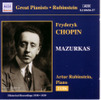Mazurka in A Minor, Op. 17, No. 4 performed by Rubinstein (1939)

| | Label: | | Naxos 8.110656-57 | | Track: | | 13 Track Duration: 4:16 minutes | | Related Performances: | | Biret (1990), Block (1995), Brailowsky (1960), Chiu (1999), Clidat (1994), Cortot (1951), Falvay (1989), Fiorentino (1962), Flière (1977), François (1956), Hatto (1997), Horowitz (1971), Horowitz (1985), Indjic (2001), Kissin (1993), Luisada (1990), Magaloff (1977), Magaloff (1977), Paderewski (1912), Perahia (1994), Rosen (1989), Rubinstein (1966), Rummel (1943), Shebanova (2002), Smith (1975), Ts'ong (1993), Uninsky (1971), Weissenberg (1971) |
|
Raw Data
Below are the 5 individual tempo tapping trials for the reverse
conducting of this performance. Click on a
trial number to view the timing data for a particular trial.
Header information from first trial file:
| performance-id | | pid9049-13
|
| title | | Mazurka in A minor, Op. 17, No. 4
|
| trial | | 01/05
|
| date | | 2005/02/23/
|
| reverse-conductor | | Craig Stuart Sapp
|
| performer | | Artur Rubinstein
|
| performance-date | | 1939
|
| label | | Naxos 8.110656-57
|
| label-title | | Fryderyk Chopin: Mazurkas
|
| trial-hardware | | Sony Vaio PCG-R505GC laptop
|
| trial-cpuspeed | | 1193.084 MHz
|
| trial-os | | Windows XP
|
The individual trials are combined into a single file for
analysis in Mathematica:
Analysis Data
The absolute beat times in the music are extracted from
pid9049-13.avg and stored
in a plain text file. The following data is useful for generating clicktracks
for the audio recording of the performance.
|
The average beat file pid9049-13.ma is missing.
|
Next, the offsets analyzed in Mathematica are added to
each individual trial in another combined trial file for use
in further analysis of the individual trials. The average values
of the data in the following file whould give you the average
performance times listed in the above file:
|
The combined file pid9049-13-abs.ma is missing.
|
Score Alignment Data
The beat times are first attached to the original score:
|
the file pid9049-13.btime is missing
|
Then the times of sub-beats are interpolated from the beat times:
|
the file pid9049-13.time is missing
|
Performance Analysis Data
Finally, the timing information for all individual notes in the score are extracted to a file for use in automatic note identification in an audio file of the performance:
|
the file pid9049-13.notes is missing
|
Where the columns represent the following information about a note:
- abstime -- average absolute time in milliseconds of human beats where the note is expected to be in the audio file.
- duration -- expected duration in milliseconds of the note based on score duration.
- note -- MIDI note number of pitch (60 = middle C, 61 = C-sharp/D-flat, etc.).
- metlev -- metric level of the note: 1 = occurs on a downbeat; 0 = occurs on another beat in the measure; -1 = occurs on an offbeat.
- measure -- The measure number in which note occurs.
- absbeat -- The absolute beat from starting beat at 0 for the first beat of the composition.
- mintime -- minimum absolute time of human tapping for this note.
- maxtime -- maximum absolute time of human tapping for this note.
- sd -- standard deviation of human tapping time in milliseconds.
|



